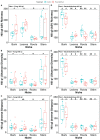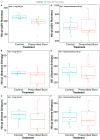Signatures of prescribed fire in the microbial communities of Cornus florida are largely undetectable five months post-fire
- PMID: 37641599
- PMCID: PMC10460572
- DOI: 10.7717/peerj.15822
Signatures of prescribed fire in the microbial communities of Cornus florida are largely undetectable five months post-fire
Abstract
Prescribed burn is a management tool that influences the physical structure and composition of forest plant communities and their associated microorganisms. Plant-associated microorganisms aid in host plant disease tolerance and increase nutrient availability. The effects of prescribed burn on microorganisms associated with native ecologically and economically important tree species, such as Cornus florida L. (flowering dogwood), are not well understood, particularly in aboveground plant tissues (e.g., leaf, stem, and bark tissues). The objective of this study was to use 16S rRNA gene and ITS2 region sequencing to evaluate changes in bacterial and fungal communities of five different flowering dogwood-associated niches (soil, roots, bark, stem, and leaves) five months following a prescribed burn treatment. The alpha- and beta-diversity of root bacterial/archaeal communities differed significantly between prescribed burn and unburned control-treated trees. In these bacterial/archaeal root communities, we also detected a significantly higher relative abundance of sequences identified as Acidothermaceae, a family of thermophilic bacteria. No significant differences were detected between prescribed burn-treated and unburned control trees in bulk soils or bark, stem, or leaf tissues. The findings of our study suggest that prescribed burn does not significantly alter the aboveground plant-associated microbial communities of flowering dogwood trees five months following the prescribed burn application. Further studies are required to better understand the short- and long-term effects of prescribed burns on the microbial communities of forest trees.
Keywords: 16S rRNA; Cornus florida; Flowering dogwood; Internal transcribed spacer (ITS); Microbial communities; Microbiome; Native trees; Phytobiome; Plant–microbe interactions; Prescribed fire.
© 2023 Kapoor et al.
Conflict of interest statement
The authors declare that they have no competing interests.
Figures









References
-
- Barreiro A, Díaz-Raviña M. Fire impacts on soil microorganisms: mass, activity, and diversity. Current Opinion in Environmental Science & Health. 2021;22:100264. doi: 10.1016/j.coesh.2021.100264. - DOI
-
- Bell TH, Hockett KL, Alcalá-Briseño RI, Barbercheck M, Beattie GA, Bruns MA, Carlson JE, Chung T, Collins A, Emmett B, Esker P, Garrett KA, Glenna L, Gugino BK, del Jiménez-Gasco Mía M, Kinkel L, Kovac J, Kowalski KP, Kuldau G, Leveau JHJ, Michalska-Smith MJ, Myrick J, Peter K, Salazar MFV, Shade A, Stopnisek N, Tan X, Welty AT, Wickings K, Yergeau E. Manipulating wild and tamed phytobiomes: challenges and opportunities. Phytobiomes Journal. 2019;3:3–21. doi: 10.1094/PBIOMES-01-19-0006-W. - DOI
-
- Berry A, Barabote R, Normand P. The family acidothermaceae. In: Rosenberg E, DeLong EF, Lory S, Stackebrandt E, Thompson F, editors. The Prokaryotes. Berlin, Heidelberg: Springer; 2014. - DOI
-
- Bonanomi G, Idbella M, Abd-ElGawad AM, Motti R, Ippolito F, Santorufo L, Adamo P, Agrelli D, De Marco A, Maisto G, Zotti M. Impact of prescribed burning, mowing and abandonment on a Mediterranean grassland: a 5-year multi-kingdom comparison. Science of the Total Environment. 2022;834(4):155442. doi: 10.1016/j.scitotenv.2022.155442. - DOI - PubMed
-
- Borgogni F, Lavecchia A, Mastrolonardo G, Certini G, Ceccherini MT, Pietramellara G. Immediate-and short-term wildfire impact on soil microbial diversity and activity in a Mediterranean forest soil. Soil Science. 2019;184(2):35–42. doi: 10.1097/SS.0000000000000250. - DOI
Publication types
MeSH terms
Substances
LinkOut - more resources
Full Text Sources

